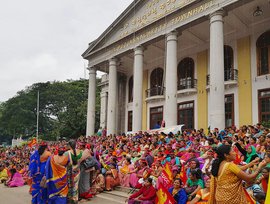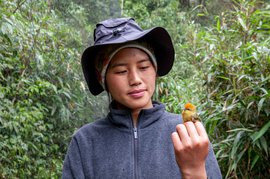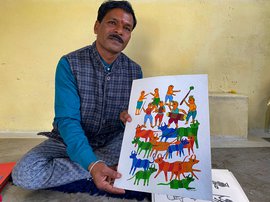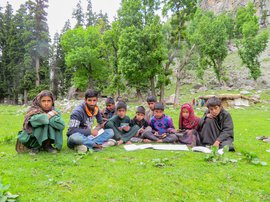“What is bad about inequality?” A perplexed student asks us during a presentation on PARI in a private school in Bangalore.
“The kirana [small shop] owner has his small store and Ambani has his big business because of how hard they work. People who work hard, succeed,” he says, confident with his logic.
Unpacking ‘success’ in this space is possible with a PARI story on the unequal access to education, healthcare and justice. We draw on them in classrooms to share the lives of hardworking people – on farms, in forests and the underbelly of cities, and more.
Our work in education brings PARI journalists into classrooms to engage with young people on the issues of our times. In schools and universities, in both urban and rural India, we offer different realities through our archive of stories, photos, films, music and art.
Students like Chennai high schooler, Arnav admit, “we view them [people below their socio-economic group] as statistics rather than an actual person who goes through things we often go through.”


Left: At a session in Punjabi University, Patiala, on the need for more rural stories in mainstream media. Right: At a workshop with young people at the School for Democracy in Bhim, Rajasthan on how to write about marginalised people
Social issues are complex, but sometimes it takes just a story to break it down: Cutting cane for 2,000 hours is about agricultural farmers in Beed district of Maharashtra who travel to sugarcane fields looking for work – up to 14 hours a day, chopping at the hard cane ready for harvest. The story has personal anecdotes by them and powerful images of their desperation for work that explains why 6 lakh agricultural workers in Marathwada make the annual journeys to cut cane.
Sugarcane workers tell a larger story of an intensifying agrarian crisis caused by a multiplicity of factors, poor policies, rising input costs, unpredictable climate patterns and more. These families must take their children with them who end up staying out of school for long periods, weakening their academic learning, leading to uncertain futures that could resemble their parents' lives.
This real life example of the 'vicious cycle of poverty', a term frequently seen in textbooks now gains a human telling in the class – children speaking to children.
Stories like these can help dispel the common misnomer that economic success is merely a product of capability.
In the classroom, the line on ‘success’ is now countered by another kid who shoots back with, “but a rickshawallah works very hard too.”
We not only want to promote critical thinking about societies through original stories, personal anecdotes, verified data, and storytelling, but also build empathy and move them out of their comfort zone. "You really pushed us to notice life outside of ours,” a college student in Delhi said to us.


Sugarcane workers are affected by an agrarian crisis caused by poor policies and unpredictable climate. Their children miss school due to travel. 'Success' isn't just about hard work
We also work with teachers who then take off from where we left. They dig into PARI for their lessons on (say) thermal and green energy, and show short videos on livelihoods and cultures that tell it like it is. Language teachers are thrilled when they see the professionally translated stories that can be used as teaching material: “Do you have a Punjabi version of this story?” they ask. And we do! In 14 languages. For university professors, it’s the free-to-access library among other resources on PARI that calls out to them.
*****
India has slipped to rank 161 in the 2023 World Press Freedom Index. This is out of 180 countries, according to a report by the global media watchdog, Reporters Without Borders (RSF).
How do you make this alarming ‘undemocratic’ fact hit home to young people who are constantly bombarded with fake news on social media, undermining the credibility of real journalists?
Universities have the space, but schoolrooms almost without exception, don’t.
At PARI we are using the power of our stories – in photos, videos and multiple languages – to show how good journalism can uncover the truth about those in power, and give power to those telling their truths.
Stories on folk artistes, on a postman, local conservationists, rubber tappers, women who collect scraps of coal, and skilled artisans among others, teach students to listen and learn outside the textbook, challenging notions about knowledge systems.


Left: PARI at the Chandigarh Children's Literature Festival, engaging with students on stories about people in rural India. Right: After a session with the Sauramandala Foundation in Shillong, Meghalaya, on the role of the media in democracies
We don't claim to be subject experts. As journalists in the classroom our aim is to encourage an environment where young people question state power, challenge stereotypes and biases in news coverage, and call out caste and class privileges – as a way to learn about the world they are inheriting.
Sometimes, we get pushback from staff. There is a reluctance to introduce caste issues in classrooms.
But, not amplifying these stories and leaving them out of school classrooms is setting the stage for tomorrow’s citizens to be oblivious and ignorant of the obvious and subtle tyrannies of caste oppression.
Our story, ‘No life should end in the gutter’ told students a story about a worker who died in the drain in a Vasant Kunj mall, an upmarket area in the capital of the country. They were shocked, not only because of the nature of such illegal and potentially fatal work, but also because of the proximity of the incident: only a few kilometres away from their school.
By ‘shielding’ or ‘ignoring’ such issues in our classrooms, we contribute to the false image of ‘India Shining’.
After we show students such stories, they always ask us how they can help.


Left: ' No life in the gutter' told students a story about a worker who died in the drain in a Vasant Kunj mall. Right: Masters student at Azim Premji University, Dipshikha Singh, dove right into the deep end with her uncovering of female dancers' struggles at Bihar weddings
While we appreciate their eagerness to find immediate solutions, as field reporters and journalists, our aim, however, is to increase their appetite for examining and re-examining life around them rather than providing quick fixes.
We want students to not just take our word for it, so we encourage them to go out and document things around them, while they are students. PARI Education has worked with over 200 institutions and thousands of students since it was launched in 2018. We carry their work from across India: postgraduates to highschoolers are learning by doing and you can read all their work here on PARI .
It’s our ‘unselfie’ approach – in which we get them to move away from blog writing about themselves to documenting someone else’s life, amplifying their voice, learning from their lives and livelihoods.
A Masters student at Azim Premji University, Dipshikha Singh, dove right into the deep end with her uncovering of female dancers' struggles at Bihar weddings – a profession often whitewashed in glamorous Bollywood item numbers. “Men put their hands on our waist or try to force their hands into our blouses. Such acts are an everyday affair here,” says one of the dancers who spoke on conditions of anonymity about the social and economic harassment they face daily.
For Dipshikha, now working in the social sector, the process of meeting, enquiring and having conversations with the dancers has been the learning: “This experience [of documenting] marks a significant milestone in my writing journey, and has also inspired me to continue sharing stories that matter… hope to contribute more to PARI's mission,” she wrote to us.
PARI Education also collaborates with rural schools and students to help them document issues close to their homes and hearts. In their language. A group of pre-teens reported on the haat – weekly market – in Jurudi, Odisha. They visited the haat multiple times and interviewed buyers and sellers to gather information for their report .


Left: In Jurudi, Odisha, school reporters document the people and produce they sell at a vibrant weekly haat (market) Right: Student reporter Aysha Joyce profiles N. Saramma, a waste collector who runs an open kitchen in Trivandrum. Saramma's story touched thousands of readers across India, many offering to support her work via donations
The reporters, Ananya Topno, Rohit Gagrai, Akash Eka and Pallabi Lugun said to PARI about the experience: “Doing this kind of [research] work is something new for us. We saw people haggling with vegetable sellers, but we know how hard it is to grow vegetables. We wonder why people argue about prices with farmers?”
Even those students who don’t go to rural India, find there is much to write about, like the story of N. Saramma , a waste collector who runs an open kitchen in Trivandrum. “I strictly adhere to the rule that nobody should be hungry because I faced severe poverty during my childhood,” Saramma is quoted as saying.
The story was written by Aysha Joyce and received thousands of likes and comments from readers who wanted to help. “Who will give a job to a Dalit?” says Saramma when asked why her daughter does the same work. “People always check who you are in relation to other people. No matter how smartly we do things, whatever we do, there is no escape,” she told Aysha.
We also train them on interviewing techniques, obtaining informed consent from interviewees, and the necessity of capturing a cross-section of details that engage the reader. Importantly, students also learn how to write and structure these stories so that they appear as objective pieces of reporting instead of a personal blog.
While journalism is often associated with long-form investigative pieces supported by multiple sources and data, we encourage our students to write simple profiles of people. These profiles document the daily experiences of individuals, the nature of their work, the hours they put in, the joy they derive, the struggles they face, their resilience in the face of odds, the economics of their lives, and the aspirations they have for their children.
PARI Education is our attempt to get young people to recognise and appreciate societal issues using an honest journalistic lens. By focusing on the people and their stories, students bring humanity back to journalism, and also into their classrooms.
If you would like PARI to work with your institution, please write to [email protected]
The feature image in this article was taken by Binaifer Bharucha, PARI's Photo Editor.




